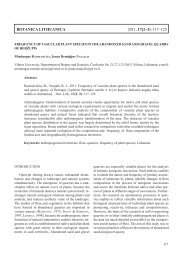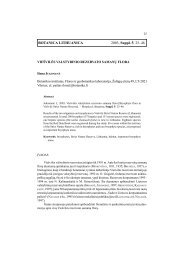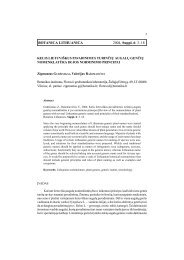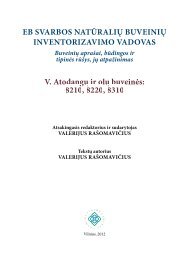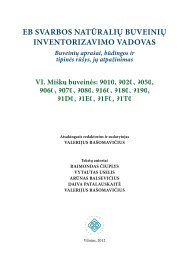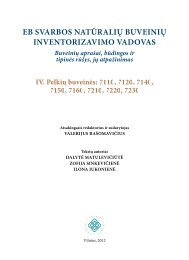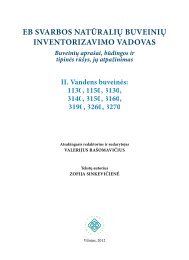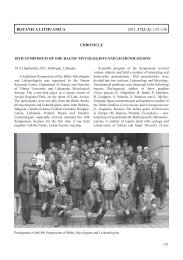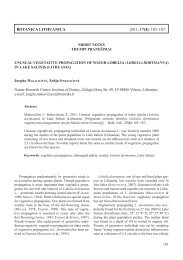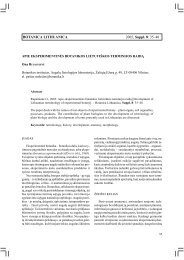FUNGI AND LICHENS IN THE BALTICS AND BEYOND XVIII ...
FUNGI AND LICHENS IN THE BALTICS AND BEYOND XVIII ...
FUNGI AND LICHENS IN THE BALTICS AND BEYOND XVIII ...
Create successful ePaper yourself
Turn your PDF publications into a flip-book with our unique Google optimized e-Paper software.
known from a few localities; 4) easily visible species. The ecological features and the<br />
distribution of species were also taken in account. For example, preference was given to<br />
moderately rare species inhabiting highly populated and transformed territories over more rare<br />
species inhabiting less disturbed parts of the region. We suppose that the lichen red list should<br />
be combined on the base of rather other principles: 1) naturally rare species with scattered<br />
decreasing distribution area in Russia or in the World; 2) regionally rare species which are<br />
situated on the border of their distribution within LR; 3) species connected to rare and most<br />
valuable plant communities and landscapes within LR; 4) species listed in RDB of Russia<br />
(2008).<br />
The recent lichenological investigations in LR make obvious that current red list<br />
doesn’t cover the whole species diversity requiring protection. The increasing of the list to<br />
90–95 species should make it more representative for purposes of revealing and protection of<br />
the most valuable and unique communities as well as of conservation of the whole lichen<br />
flora.<br />
According to current rules the RDB must be re-published every ten years.<br />
Unfortunately due to economical reasons the republishing of RDB of LR is shelved.<br />
PHYLOGENETIC STUDIES OF THREE PENDENT Usnea SPECIES<br />
F. HÖGNABBA 1 , H. RÄMÄ 2 , P. HALONEN 3 , H. L<strong>IN</strong>DGREN 1 , S. VELMALA 1 ,<br />
S. STENROOS 1 , L. MYLLYS 1<br />
1 Botanical Museum, Finnish Museum of Natural History, P.O. Box 7, University of Helsinki,<br />
FI-00014 Helsinki, Finland<br />
2 Senjavegen 25, N-9012 Tromsø, Norway<br />
3 Botanical Museum, Department of Biology, P.O. Box 3000, University of Oulu, FI-90014<br />
Oulu, Finland<br />
E-mails: filip.hognabba@helsinki.fi, heini.rama@gmail.com, pekkahalonen@hotmail.fi,<br />
hanna.lindgren@helsinki.fi, saara.velmala@helsinki.fi, soili.stenroos@helsinki.fi,<br />
leena.myllys@helsinki.fi<br />
The taxonomy of the pendent Usnea species U. barbata, U. chaetophora. and U.<br />
dasypoga (lichen-forming ascomycetes) has remained unclear. The species have similar<br />
chemistry and have been distinguished based on morphological features. The characters used<br />
to separate the species are however not always clear-cut and the species delimitation is often<br />
problematic. In this study the phylogenetic relationships of the three pendent Usnea species<br />
are reconstructed to get a framework for better understanding the taxonomy of the species. To<br />
reconstruct the phylogenetic relationships ITS1-5.8S-ITS2 sequences in a parsimony analysis<br />
were used. The variation in the sequence data was low. The results from the phylogenetic<br />
analysis confirm the taxonomic problems of the species, as none of the three species form<br />
monophyletic entities. However, most of the examined U. chaetophora specimens are<br />
included in one clade. Also most of the U. dasypoga specimens are included in one<br />
phylogenetic group. U. chaetophora and U. dasypoga might therefore be considered distinct<br />
species although there are still some problems with the species definitions. The examined U.<br />
barbata specimens are included in several distantly related clades and probably consist of<br />
several species. Preliminary findings indicate that the taxonomy of the three pendent Usnea<br />
species needs to be revised, however further studies including more loci is needed before final<br />
conclusions can be made.



